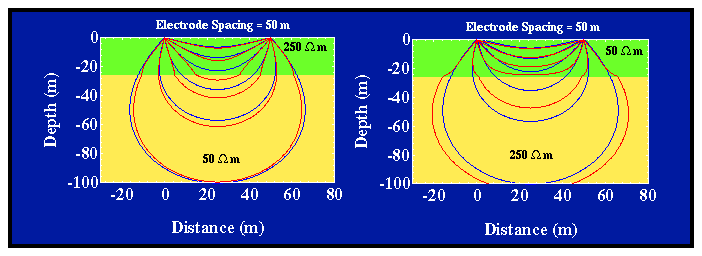
How does the presence of depth variations in resistivity affect the flow of electrical current? In the previous examples, we assumed that the Earth has a constant resistivity. Obviously, this isn't true or else we wouldn't be trying to map the variation in resistivity throughout the Earth. Although resistivity could conceivably vary in depth and in horizontal position, we will initially only consider variations in depth. In addition, we will assume that these depth variations in resistivity can be quantized into a series of discrete layers, each with a constant resistivity. Thus, initially we will not consider variations in resistivity in the horizontal direction or continuous variations with depth*.
Shown below are current-flow paths (red) from two current electrodes in two simple two-layer models. The model to the left contains a high-resistivity layer (250 ohm-m) overlying a lower resistivity layer (50 ohm-m). This model is characteristic of the resistivity profile that would be found in a region where unsaturated alluvium overlies water saturated alluvium. The model to the right contains a low-resistivity layer (50 ohm-m) overlying a higher resistivity layer (250 ohm-m). This model is characteristic of a perched aquifer. For comparison, we've also shown the paths current would have flowed along if the Earth had a constant resistivity (blue) equal to that of the top layer. These paths are identical to those described previously.

Notice that the current flow in the layered media deviates from that observed in the homogeneous media. In particular, notice that in the layered media the current flow lines are distorted in such a way that current preferentially seems to be attracted to the lower-resistivity portion of the layered media. In the model on the left, current appears to be pulled downward into the 50 ohm-m layer. In the model on the right, current appears to be bent upward, trying to remain within the lower resistivity layer at the top of the model. This shouldn't be surprising. What we are observing is the current's preference toward flowing through the path of least resistance. For the model on the left, that path is through the deep layer. For the model on the right, that path is through the shallow layer.
